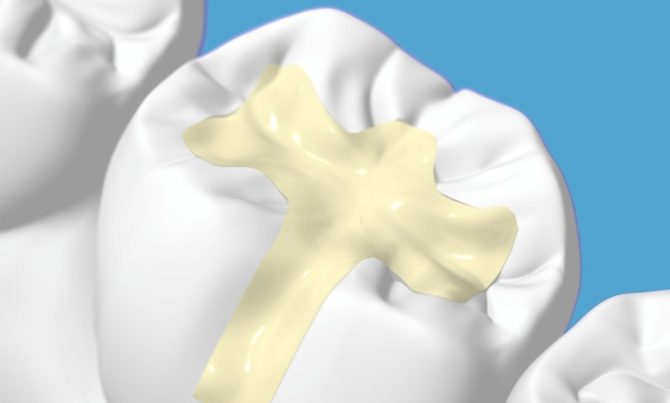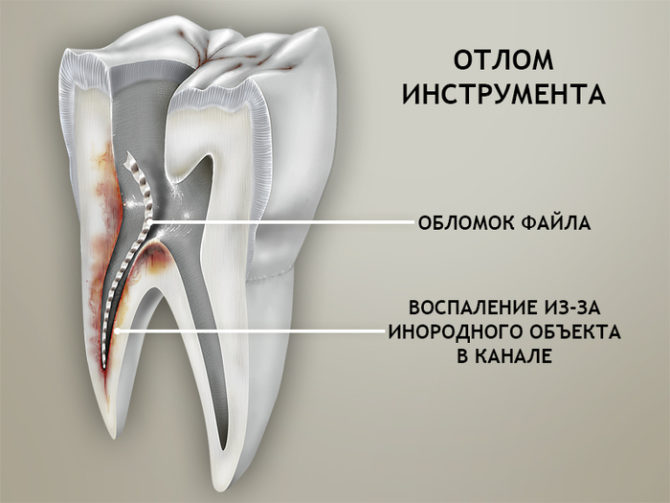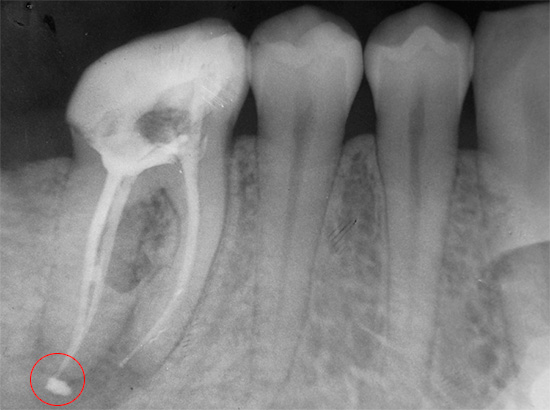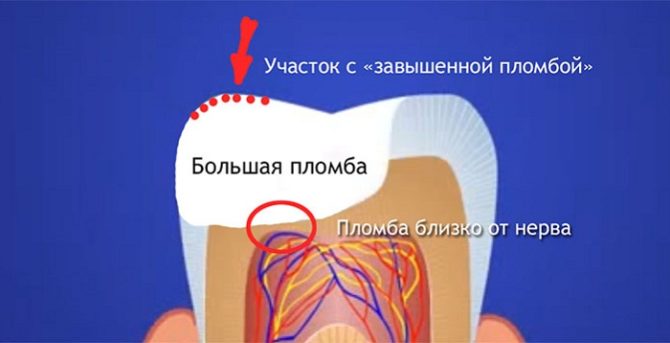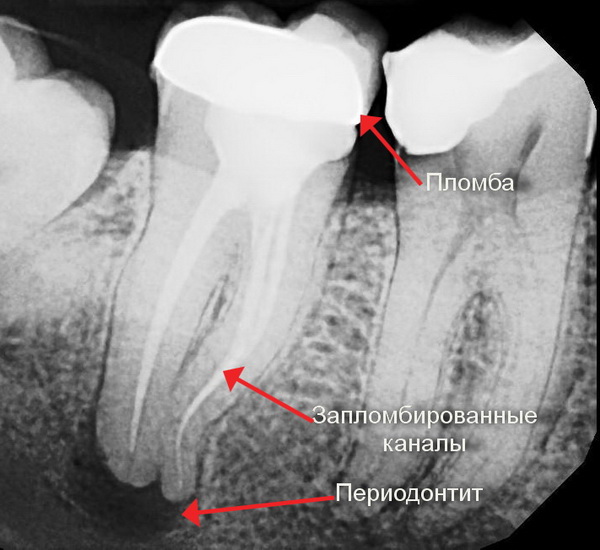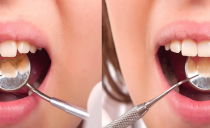A tooth ache after filling: how dangerous it is, causes and what to do
There are many reasons why aching pain occurs after filling a tooth. Some of them are not dangerous, and some evidence of serious pathologies that require immediate surgery. It is difficult to determine the cause of the pain yourself, so you should consult a doctor to clarify the diagnosis.
Content
Why does the tooth hurt after filling the canals
There are serious and non-serious causes of toothache after filling, pulp removal and canal treatment. In the first case, you must consult a doctor to eliminate the negative factor that provokes pain. In the second, it is enough to wait a while, and the unpleasant sensation will pass by itself.
Non-dangerous causes
If during the dental procedures the nerve was not removed, but the root canals or gums were injured, then the pain that occurs after the procedure goes away on its own. Provoke unpleasant sensations can:
- too cold or hot food;
- sweet foods;
- hypothermia;
- nerve stress;
- intensive cleaning;
- strong mechanical stress.
In the first days after filling, the tooth cannot be overloaded, since there is a high risk of aching pain and damage to hard tissues - it is better to chew on the other side.
The dentist must even warn the patient about the possible occurrence of pain before performing surgical procedures. After filling, the tooth always hurts, and nothing needs to be done with such pain. The main thing is to follow all the doctor’s recommendations and do not interrupt the therapy if the doctor has ordered a second visit.
Medical errors
If an X-ray examination was not performed before installing the seal, the dentist could confuse deep caries with pulpitis. Then the doctor will not clean the channels and eliminate the cause of the pathology. Until the pulpitis is cured and the nerve is removed, the pain will not stop. With a running disease, you have to pull out a tooth. Otherwise, inflammation can pass from hard to soft tissues, which cannot be determined using x-rays, especially in the early stages.
If the seal was placed in a good quality, but it still hurts a person to press a tooth and chew food, one can suspect the presence of a foreign object in the tooth. When processing the canals and the dental cavity, part of the thin dental instrument could break off and remain inside, so the tooth became ill. You can see a foreign object using x-rays.
The pain could occur after filling the canals of the tooth if the dentist incorrectly cleaned the cavity and did not neutralize the infection. If during treatment the cleaned canals of the tooth were not cooled by the air-water method, then they could overheat, since manipulations with a drill always lead to overheating of soft and hard tissues, which is fraught with the development of pulpitis or periodontitis.
Wrong seal size
If a toothache appears after or during a meal, then the tooth was filled with irregularities. The dentist could have placed the wrong size fillings on the chewing teeth. And it can be:
- too small - inside there was an unsealed space that can only be seen on an x-ray;
- too large - the filling does not allow the jaw to close tightly and interferes with biting and pressing.
For some time after the anesthesia procedure, the patient may not feel the discomfort of a new filling, the pain occurs later. In this case, the replacement of the filling is required, since it will injure the tissues that surround the root with each pressing of the tooth.
To avoid dental problems due to the doctor’s fault, you should look for a specialist according to the recommendations, but even paid treatment does not guarantee the absence of medical errors.
Allergic reaction to the material
Silver amalgam is usually used to make fillings, and a person may be allergic to this substance. In this case, in addition to pain, there are:
- itching
- skin rash;
- asthmatic attacks;
- swelling of the gums in the projection of the inflamed area (the skin also aches).
If the pain is caused by an allergic reaction to anesthesia, then it will disappear the next day. Otherwise, the tooth is filled with a composite material, but such a procedure is provided for a fee.
Toothache after filling the canals can occur due to prolonged etching of dentin with acid: a chemical damages the dentinal canals. After this, the filling material penetrates the dentinal tubules and irritates the pulp, causing pain.
Classification of pain
The cause of the pain can be determined by its intensity:
- Hypersensitivity to sweet, cold and sour is observed when setting low-quality or temporary fillings.
- Severe and throbbing pain indicates the development of acute pulpitis, which requires emergency dental treatment.
- The phenomenon when a tooth aches occasionally is the norm after filling. But sometimes such a pain syndrome signals chronic pulpitis or periodontitis.
- If it hurts during biting or pressing, you need to identify the mistake made during the filling process, for example, overdrying of the tooth cavity. But such a symptom will pass on its own over time, and therefore does not require specialized medical intervention.
- With reddened gums, along with aching toothache, an allergic reaction to filling material can be suspected, but before taking antihistamines, you should consult your dentist again.
If pain occurs, you can’t stop brushing your teeth, you can only reduce the pressure.
When to visit a dentist immediately
If the tooth after filling the canals hurts for a long time, you must consult a doctor. Moreover, the nature of the pain is not important. If in a week or two the unpleasant sensations in the dead tooth did not go away, you can’t tolerate them further.
In case of acute pain after installing the seal, you should go to the doctor immediately. Strong discomfort may indicate periodontal disease or pulpitis, and such diseases require urgent surgery.
If the tooth is not removed, then generalization of the infection and a sharp jump in temperature will occur soon. Then the infection spreads through the bloodstream, reaches the maxillary sinuses, and maybe even to the brain, which is fraught with serious consequences for human health and life.
Can I take medications
With severe pain syndromes, many are in a hurry to take antibiotics and anti-inflammatory drugs, for example, Nimesil, but taking medications without a doctor's prescription is fraught with serious consequences.Antibacterial therapy will only temporarily eliminate the focus of infection.
 For example, the same Nimesil is an effective anti-inflammatory drug. But it is used in dentistry only when a dead tooth is sealed correctly, and it is not practical to open it. Admission Nimesil is justified only in extreme cases, since the medication has a lot of contraindications and side effects.
For example, the same Nimesil is an effective anti-inflammatory drug. But it is used in dentistry only when a dead tooth is sealed correctly, and it is not practical to open it. Admission Nimesil is justified only in extreme cases, since the medication has a lot of contraindications and side effects.
Do not delay the visit to the dentist and treat the disease with the help of self-selected medications. If you need to remove a tooth to get rid of pain, pills will not save the situation.
What analgesics can be taken
If a person has a toothache with sealed canals, then In no case should you start taking anesthetic and analgesic. Medicines will relieve pain, but not the cause of inflammation. And this can lead to serious complications, even death.
In some cases, you can use traditional medicine, because they do not have side effects and do not have such a strong analgesic effect, and therefore will not be allowed to ignore a serious disease.
To relieve discomfort, rinse your mouth:
- anti-inflammatory saline with soda;
- herbal infusion of chamomile, lemon balm, sage or yarrow;
- soda solution with a small addition of iodine.
Salt and pepper
If the reasons why the tooth hurts after installing the fillings are not associated with inflammatory processes in the oral cavity and are temporary, the discomfort can be eliminated with a mixture of salt and pepper. Spices are mixed in proportions one to one and diluted with water until a homogeneous gruel is formed. After this, the mixture is applied to the inflamed area.
Medicinal herbs
Clove helps to cope with tooth pain. The plant has the following properties:
- anesthetizing;
- antibacterial;
- anti-inflammatory;
- antioxidant.
To prepare a clove “medicine”, it is necessary to chop the flowers in the amount of 2-3 heads and mix them with vegetable oil, and then rub the resulting mixture into the gum and apply it to the aching tooth.
Prepared clove oil also helps in the fight against pain. You should drip it into a glass of water (about 5-7 drops per 200 grams of liquid) and rinse your mouth with the resulting solution.
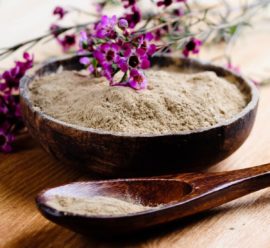 You can chew a piece of propolis or zabrus, as these honey products have a strong analgesic and anti-inflammatory effect. If the pain is localized in one area of the gum, you can put a little cosmetic clay on it. It is better to do this manipulation before bedtime, as the clay crumbles. To get rid of its residues, you should brush your teeth and rinse your mouth.
You can chew a piece of propolis or zabrus, as these honey products have a strong analgesic and anti-inflammatory effect. If the pain is localized in one area of the gum, you can put a little cosmetic clay on it. It is better to do this manipulation before bedtime, as the clay crumbles. To get rid of its residues, you should brush your teeth and rinse your mouth.
If after all the manipulations the tooth continues to hurt, you should visit the dentist: the symptom could appear due to pulpitis or periodontal disease, and they could not be cured with clay and cloves.
Simple folk remedies will help relieve pain, if its cause is harmless, but even with more serious pathologies, they will not do harm. If the gum swells and hurts in the first days after tooth filling, you can try to remove the inflammation yourself. But while maintaining symptoms for a week, you need to go to the doctor.
Prohibited Self-Medication Methods
The use of inappropriate and even dangerous methods of self-medication can lead to serious consequences and complications. When a tooth hurts, in no case should:
- put injections of medications into the gums;
- open soft tissues, trying to extract pus;
- warm and rub the tooth with alcohol-containing drinks, since thermal procedures will provoke the spread of infection;
- try to independently remove the seal, even temporary, because it is not only ineffective and painful, but also dangerous to health;
- constantly press and push on the painful area;
- apply ice to the gum;
- treat the disease with antibiotics without a doctor's prescription.
How long does a tooth ache after filling?
Filling is performed under anesthesia. When the effect of anesthesia ends, patients always feel discomfort when pressing on a cured tooth. Within a few days after visiting the doctor, pain can be observed when you press the tooth and other mechanical influences, including chewing, sometimes reactions to too cold or hot food appear - all these phenomena are natural.
Any dental manipulations are a small surgical operation, therefore it is quite natural that tissue healing takes place after them. If you press on the wound on the knee or postoperative suture, the person will also feel pain. But the tooth after filling and canal treatment can not hurt for a long time.
If the discomfort does not disappear after 4-5 days after visiting the clinic, you should re-visit the doctor. If the tooth does not fall ill immediately, but some time after the installation of the fillings, the symptom may indicate the development of an inflammatory process. Due attention should be paid to your health if unpleasant sensations appear for a long time and mainly at night or in the evening.

